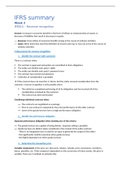Resume
International Financial Reporting Standards summary
- Cours
- Établissement
Providing a summary of the examinable subjects of International Financial Reporting Standards (excluding Inventory and Consolidation), but includes: - Revenue recognition (IFRS 15) - PPE (IAS 16) - Intangible assets (IAS 38) - Impairment (IAS 36) - Business combinations (IFRS 3) - Income tax ...
[Montrer plus]












